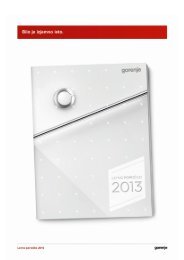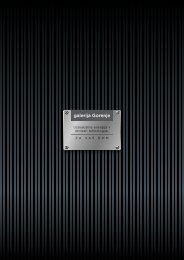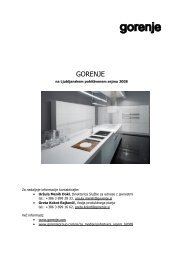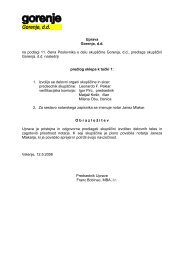ANNUAL REPORT 2008 - Gorenje Group
ANNUAL REPORT 2008 - Gorenje Group
ANNUAL REPORT 2008 - Gorenje Group
Create successful ePaper yourself
Turn your PDF publications into a flip-book with our unique Google optimized e-Paper software.
87<br />
(ii) Derivative financial instruments<br />
The <strong>Group</strong> holds derivative financial instruments to hedge its foreign currency and interest rate risk<br />
exposures. Embedded derivatives are separated from the host contract and accounted for separately<br />
if the economic characteristics and risks of the host contract and the embedded derivative<br />
are not closely related, a separate instrument with the same terms as the embedded derivative<br />
would meet the definition of a derivative, and the combined instrument is not measured at fair value<br />
through profit or loss.<br />
Derivatives are recognised initially at fair value; attributable transaction costs are recognised in<br />
profit or loss when incurred. Subsequent to initial recognition, derivatives are measured at fair value,<br />
and changes therein are accounted for as described below.<br />
Cash flow hedges<br />
Changes in the fair value of the derivative hedging instrument designated as a cash flow hedge are<br />
recognised directly in equity to the extent that the hedge is effective.<br />
If the hedging instrument no longer meets the criteria for hedge accounting, expires or is sold, terminated<br />
or exercised, then hedge accounting is discontinued prospectively. The cumulative gain or<br />
loss previously recognised in equity remains there until the forecast transaction occurs. When the<br />
hedged item is a non-financial asset, the amount recognised in equity is transferred to the carrying<br />
amount of the asset when it is recognised. In other cases the amount recognised in equity is transferred<br />
to profit or loss in the same period that the hedged item affects profit or loss.<br />
Economic hedges<br />
Hedge accounting is not applied to derivative instruments that economically hedge monetary assets<br />
and liabilities denominated in foreign currencies. Changes in the fair value of such derivatives<br />
are recognised in profit or loss as part of foreign currency gains and losses.<br />
(iii) Share capital<br />
Ordinary shares<br />
Ordinary shares are classified as equity. Incremental costs directly attributable to the issue of ordinary<br />
shares and share options are recognised as a deduction from equity, net of any tax effects.<br />
Repurchase of share capital (treasury shares)<br />
When share capital recognised as equity is repurchased, the amount of the consideration paid,<br />
which includes directly attributable costs, is net of any tax effects, and is recognised as a deduction<br />
from equity. Repurchased shares are classified as treasury shares and are presented as a deduction<br />
from total equity. When treasury shares are sold or reissued subsequently, the amount received is<br />
recognised as an increase in equity, and the resulting surplus or deficit on the transaction is transferred<br />
to retained earnings or reserves.<br />
Dividends are recognised as a liability in the period in which they are declared by the shareholders’<br />
meeting.<br />
(d) Property, plant and equipment<br />
(i) Recognition and measurement<br />
Items of property, plant and equipment are measured at cost less accumulated depreciation and<br />
accumulated impairment losses.<br />
Cost includes expenditure that is directly attributable to the acquisition of the asset. The cost of<br />
self-constructed assets includes the cost of materials and direct labour, any other costs directly at-

















